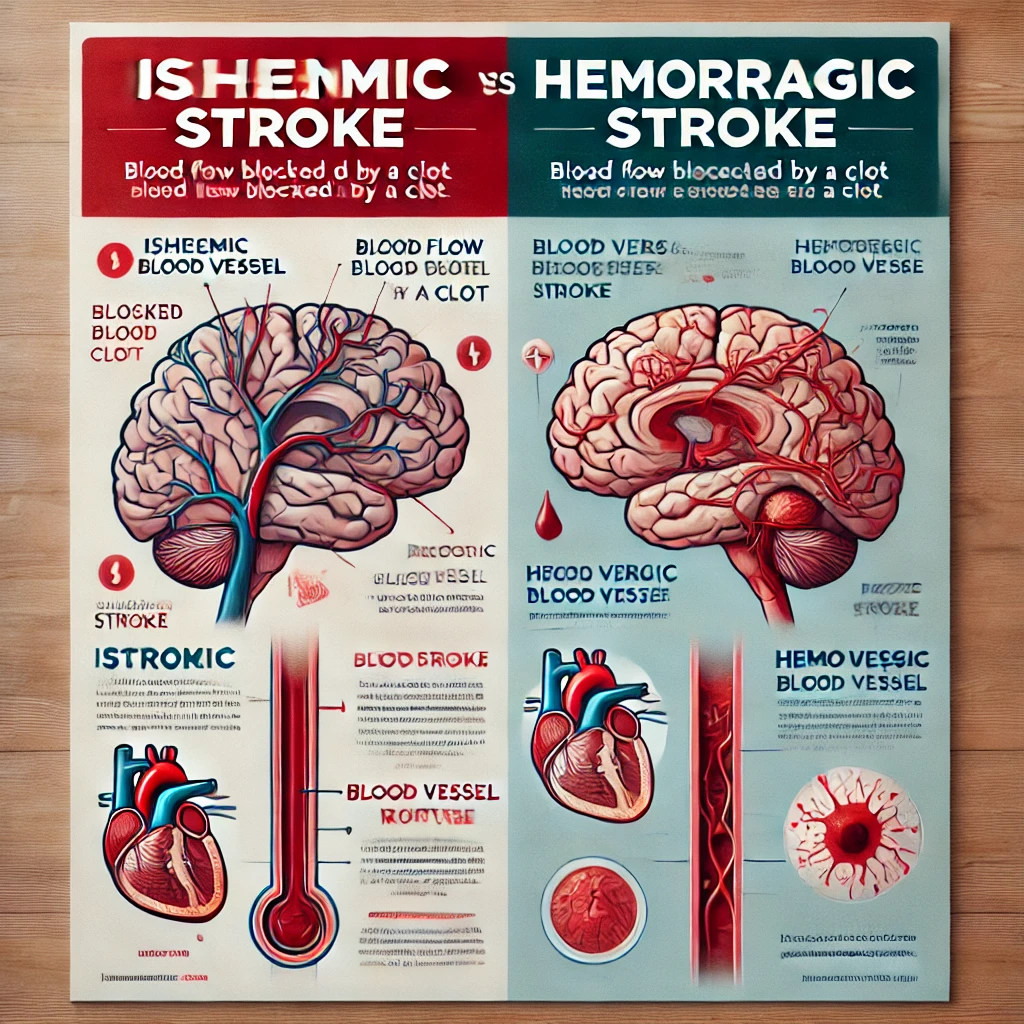Understanding the Differences Between Ischemic and Hemorrhagic Strokes
Strokes rank among the top causes of disability and death globally, highlighting the importance of understanding stroke types and their impact on the brain. The two main types, ischemic stroke and hemorrhagic stroke, differ in causes, symptoms, and treatment approaches. This article compares ischemic and hemorrhagic strokes to help you recognize stroke symptoms and the need for immediate medical intervention.

What is an Ischemic Stroke?
Ischemic strokes occur when a blood vessel supplying blood to the brain is blocked by a clot. This blockage restricts oxygen and essential nutrients from reaching brain tissue, leading to cell death. Ischemic strokes account for approximately 87% of all stroke cases.
Causes: The primary cause of ischemic stroke is the formation of a blood clot, known as a thrombus, within an artery that supplies blood to the brain. This clot can either form in the artery itself or travel to the brain from another part of the body (an embolus). Risk factors include high blood pressure, high cholesterol, diabetes, smoking, and atrial fibrillation.
Symptoms: The symptoms of an ischemic stroke often develop suddenly and can include:
- Sudden numbness or weakness, particularly on one side of the body
- Confusion or trouble speaking
- Difficulty understanding speech
- Vision problems in one or both eyes
- Difficulty walking, dizziness, or loss of balance
Treatment: The most effective treatment for an ischemic stroke is the administration of clot-busting medication known as tissue plasminogen activator (tPA). This drug must be given within a few hours of the onset of symptoms to be effective. In some cases, mechanical thrombectomy, a procedure to remove the clot using a catheter, may be necessary.
What is a Hemorrhagic Stroke?
Hemorrhagic strokes occur when a blood vessel in the brain ruptures, causing bleeding within or around the brain. This bleeding increases pressure on brain tissue, leading to damage and cell death. Hemorrhagic strokes are less common than ischemic strokes, accounting for about 13% of cases, but they tend to be more severe.
Causes: The most common cause of a hemorrhagic stroke is high blood pressure, which can weaken the walls of blood vessels over time, making them prone to rupture. Other causes include aneurysms (weakened areas of a blood vessel that bulge and burst), arteriovenous malformations (AVMs), and head injuries.
Symptoms: Symptoms of a hemorrhagic stroke can include:
A sudden, severe headache, often described as the “worst headache of my life”
Nausea or vomiting
Seizures
Loss of consciousness or fainting
Weakness, numbness, or paralysis, particularly on one side of the body
Treatment: The treatment for hemorrhagic stroke focuses on controlling the bleeding and reducing pressure in the brain. This may involve surgery to repair the damaged blood vessel, remove blood clots, or relieve pressure. Medications may also be used to control blood pressure and prevent further bleeding.
Key Differences Between Ischemic and Hemorrhagic Strokes
While both types of strokes affect brain function, they differ significantly in their causes, symptoms, and treatments:
1. Cause:
Ischemic Stroke: Caused by a blockage in a blood vessel (clot).
Hemorrhagic Stroke: Caused by the rupture of a blood vessel.
2. Symptoms:
Ischemic Stroke: Sudden numbness or weakness, speech difficulties, vision problems.
Hemorrhagic Stroke: Severe headache, nausea, seizures, loss of consciousness.
3. Treatment:
Ischemic Stroke: tPA medication, mechanical thrombectomy.
Hemorrhagic Stroke: Surgical intervention, blood pressure management.
4. Prevalence:
Ischemic Stroke: Accounts for 87% of strokes.
Hemorrhagic Stroke: Accounts for 13% of strokes.
Conclusion
Understanding the differences between ischemic and hemorrhagic strokes is essential for recognizing symptoms and seeking timely medical intervention. While ischemic strokes are more common, hemorrhagic strokes tend to be more severe, requiring immediate medical attention. Awareness of the risk factors, symptoms, and treatments for each type of stroke can help improve outcomes and potentially save lives.
If you or someone you know exhibits symptoms of a stroke, remember to act F.A.S.T. (Face drooping, Arm weakness, Speech difficulties, Time to call emergency services) and seek immediate medical help.

